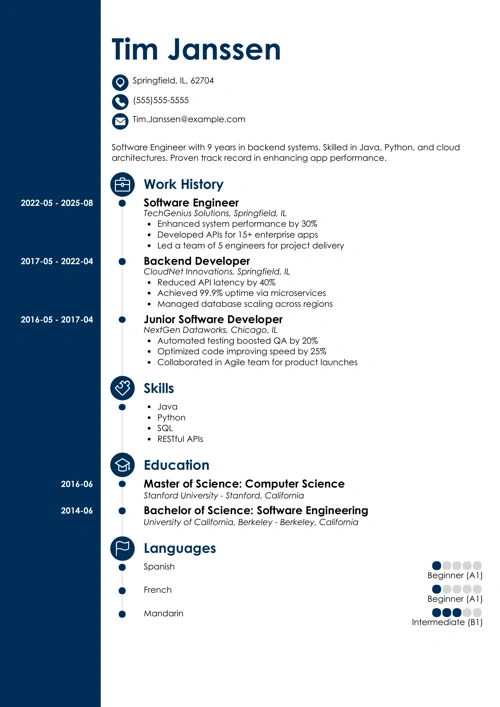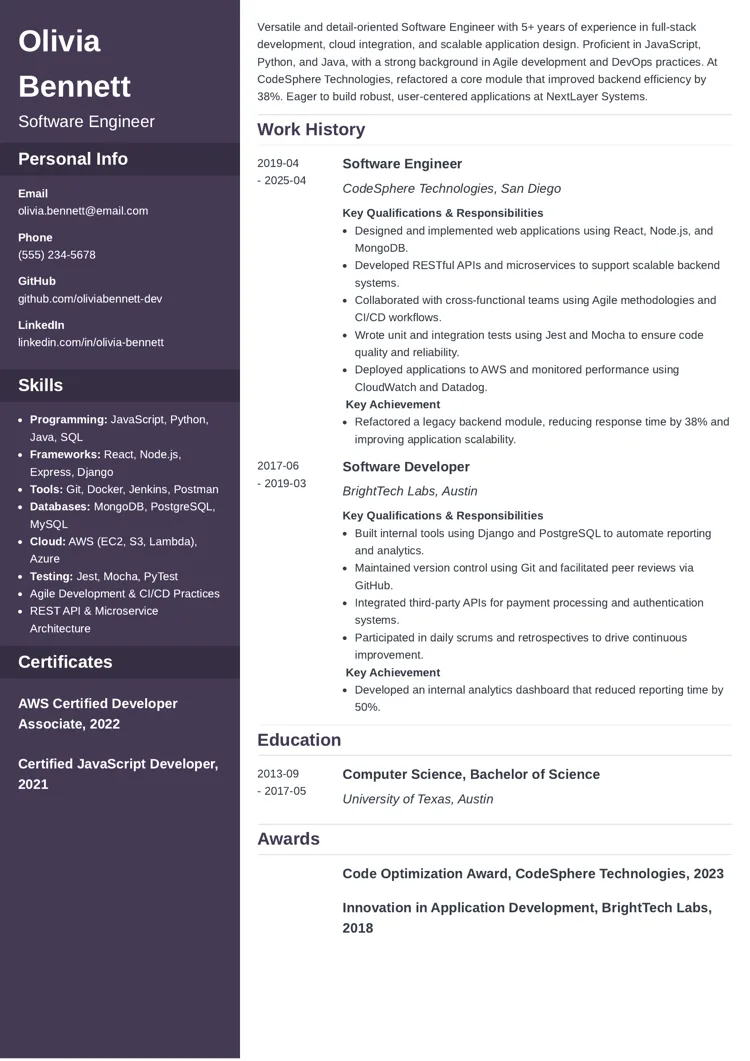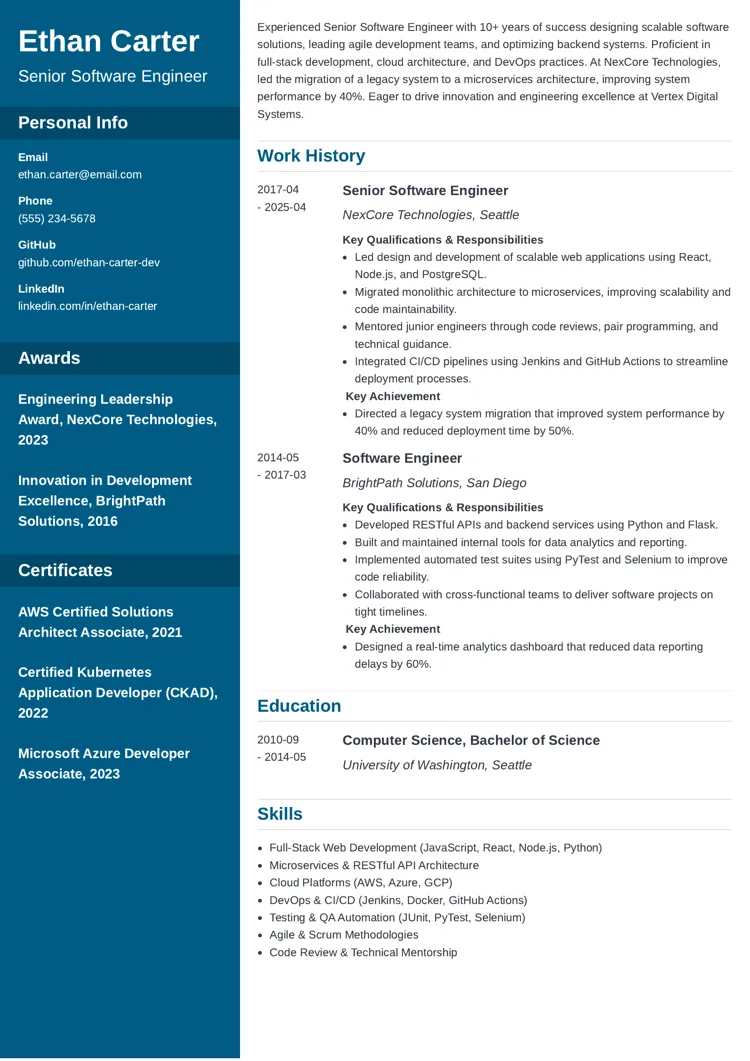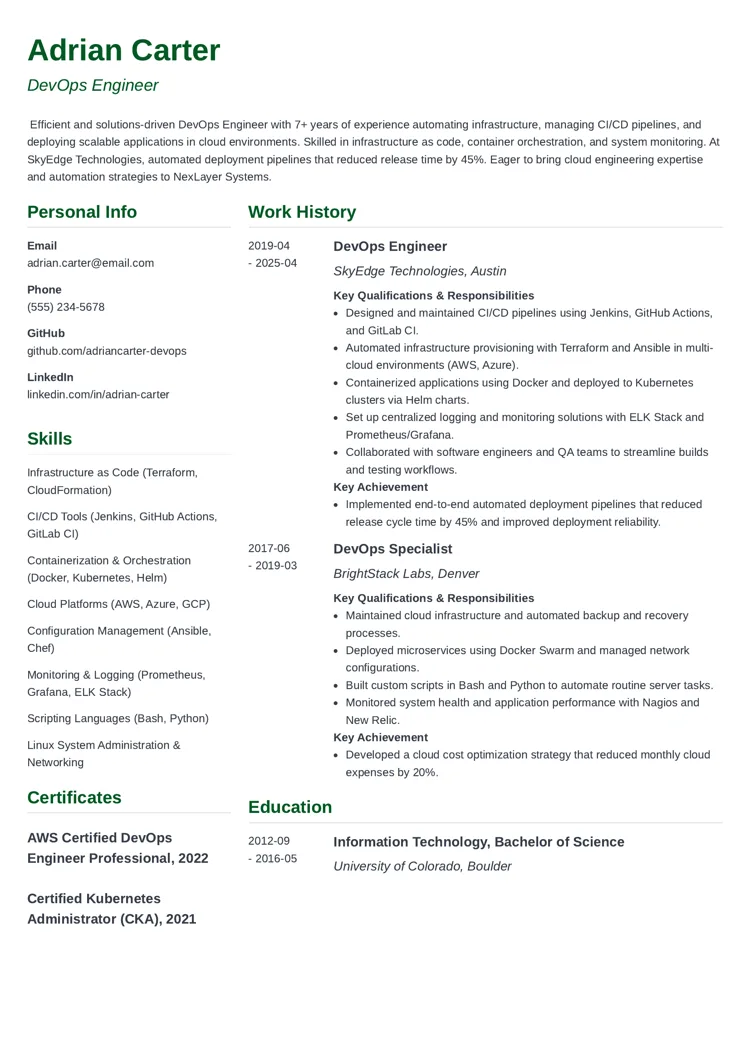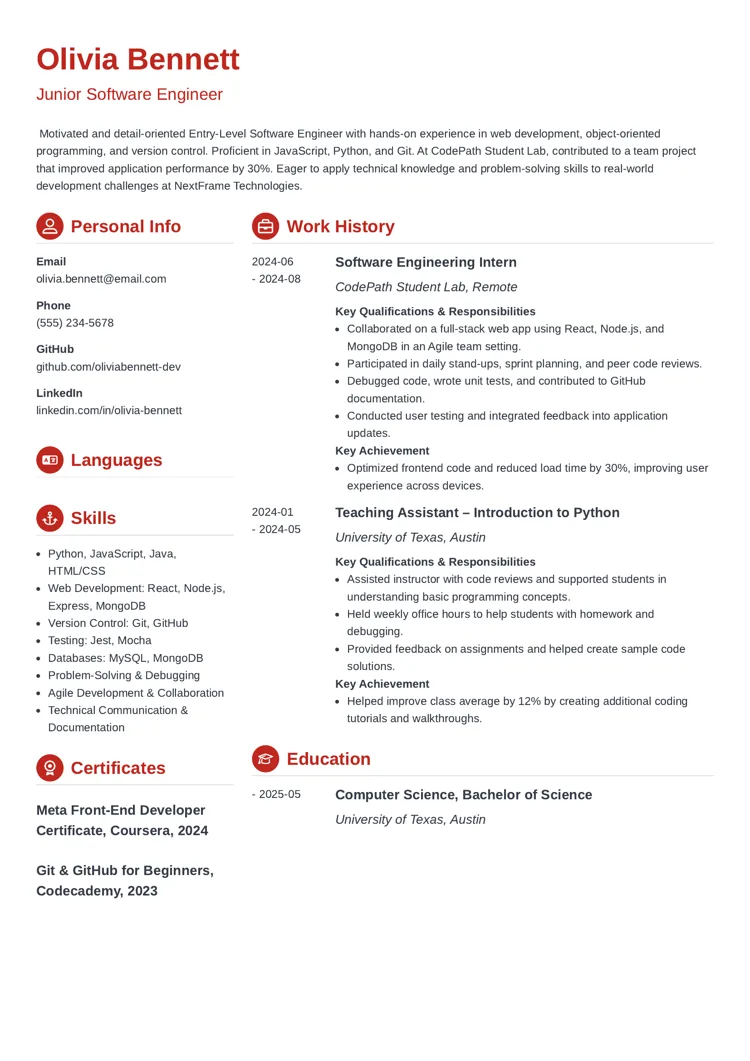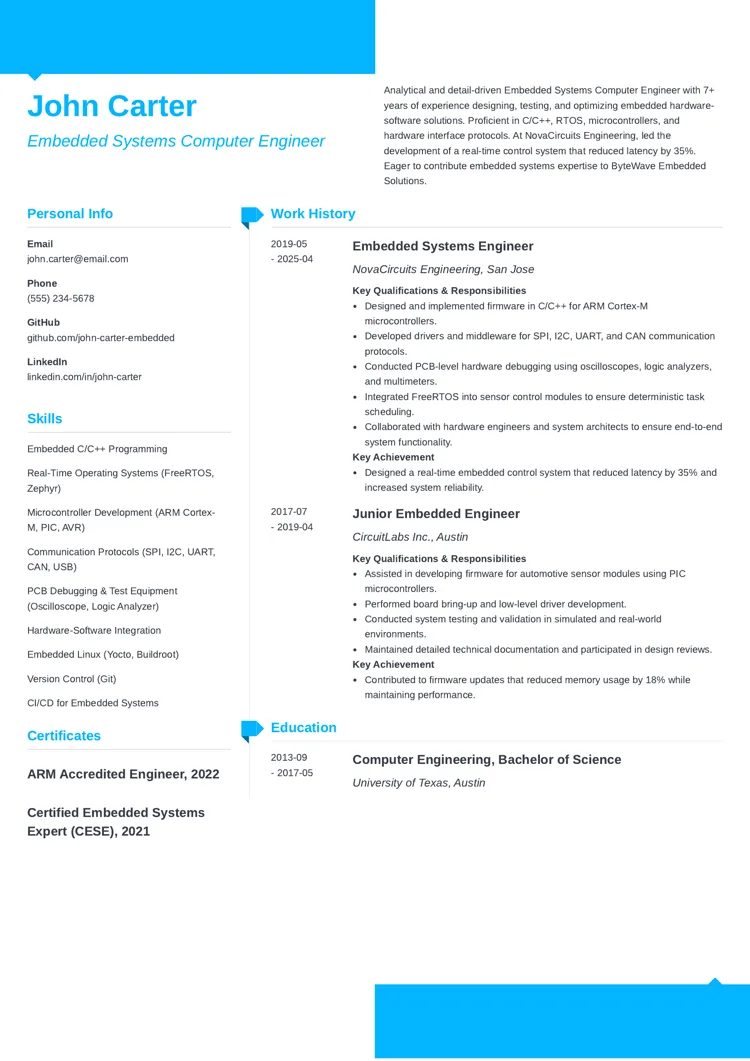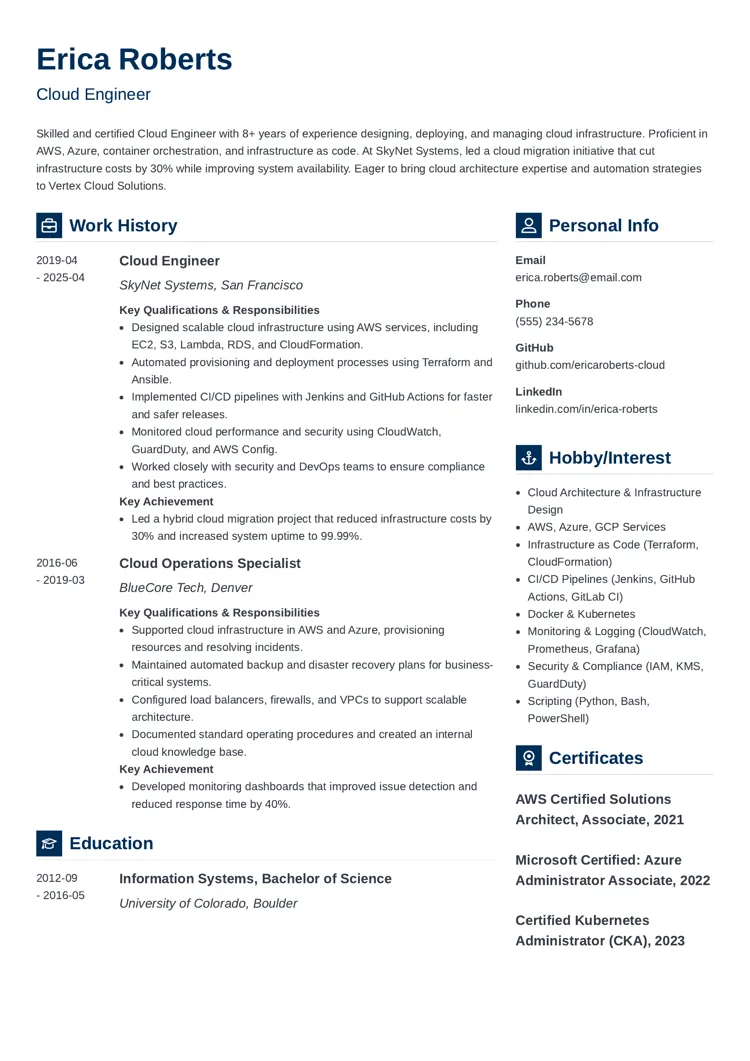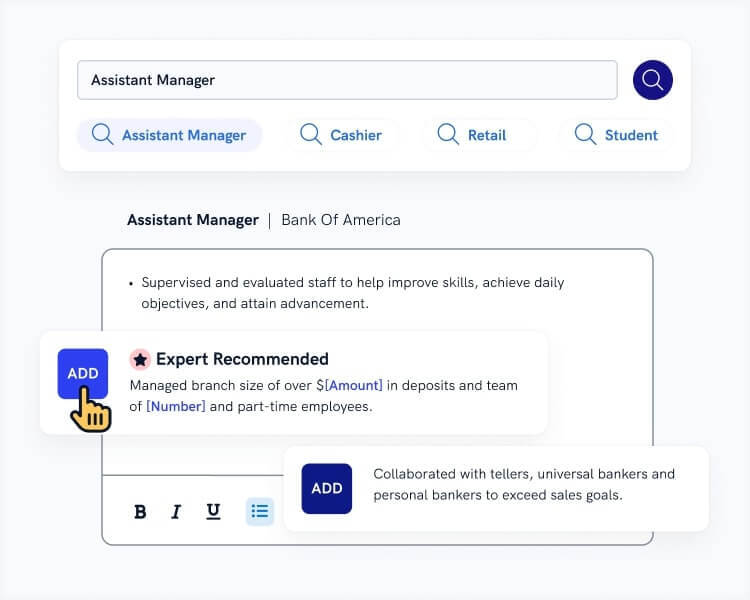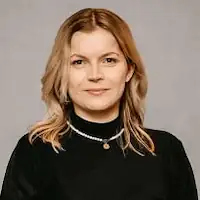Writing a software engineer resume shouldn’t feel like launching a product without QA. Whether you're a junior dev or a full-stack wizard, your resume needs clean code and smart design. With our expert-backed tips, software engineer resume examples, and a job-winning software engineer resume template, you’ll debug the job search process in no time.
Ready to turn your GitHub repo into a job offer? Let’s build a resume that compiles perfectly with every recruiter’s expectations.
Top Article Insights:
- Software engineer resume example & template to copy & paste
- More resume examples for senior software engineers, DevOps engineers, cloud engineers, etc.
- Step-by-step guide on how to write a software engineer resume
Software Engineer Resume Example
Software Engineer Resume Template to Copy & Paste (Text Version)
Olivia Bennett
Software Engineer
(555) 234-5678
olivia.bennett@email.com
linkedin.com/in/olivia-bennett
github.com/oliviabennett-dev
Summary
Versatile and detail-oriented Software Engineer with 5+ years of experience in full-stack development, cloud integration, and scalable application design. Proficient in JavaScript, Python, and Java, with a strong background in Agile development and DevOps practices. At CodeSphere Technologies, refactored a core module that improved backend efficiency by 38%. Eager to build robust, user-centered applications at NextLayer Systems.
Experience
Software Engineer
CodeSphere Technologies, San Diego, CA
April 2019–April 2025
Key Qualifications & Responsibilities
- Designed and implemented web applications using React, Node.js, and MongoDB.
- Developed RESTful APIs and microservices to support scalable backend systems.
- Collaborated with cross-functional teams using Agile methodologies and CI/CD workflows.
- Wrote unit and integration tests using Jest and Mocha to ensure code quality and reliability.
- Deployed applications to AWS and monitored performance using CloudWatch and Datadog.
Key Achievement
- Refactored a legacy backend module, reducing response time by 38% and improving application scalability.
Software Developer
BrightTech Labs, Austin, TX
June 2017–March 2019
Key Qualifications & Responsibilities
- Built internal tools using Django and PostgreSQL to automate reporting and analytics.
- Maintained version control using Git and facilitated peer reviews via GitHub.
- Integrated third-party APIs for payment processing and authentication systems.
- Participated in daily scrums and retrospectives to drive continuous improvement.
Key Achievement
- Developed an internal analytics dashboard that reduced reporting time by 50%.
Education
Bachelor of Science in Computer Science
University of Texas, Austin, TX
September 2013–May 2017
Skills
- Programming: JavaScript, Python, Java, SQL
- Frameworks: React, Node.js, Express, Django
- Tools: Git, Docker, Jenkins, Postman
- Databases: MongoDB, PostgreSQL, MySQL
- Cloud: AWS (EC2, S3, Lambda), Azure
- Testing: Jest, Mocha, PyTest
- Agile Development & CI/CD Practices
- REST API & Microservice Architecture
Certifications
- AWS Certified Developer Associate, 2022
- Certified JavaScript Developer, 2021
Awards
- Code Optimization Award, CodeSphere Technologies, 2023
- Innovation in Application Development, BrightTech Labs, 2018
Senior Software Engineer Resume Example
What Do I Think About This Example? (Expert Tips)
This resume template feels like a great match for a senior software engineer. The sidebar layout helps keep certifications, skills, and contact info easy to access—something I really value when scanning technical resumes. I also like how the main content area allows plenty of space to showcase professional achievements. It’s structured, clean, and has the right amount of visual interest without being distracting.
Find out more about: Senior Software Engineer Resume Example
DevOps Engineer Resume Example
What Do I Think About This Example? (Expert Tips)
What stands out to me in this resume is how clearly it reflects the technical depth expected from a DevOps Engineer. The skills section is neatly grouped and instantly tells me this candidate knows their tools: Terraform, Jenkins, Kubernetes, AWS—it’s all there. I also appreciate how the layout balances strong visual structure with simplicity. It lets the achievements shine, like reducing release time by 45%, without distractions. If I were hiring for a DevOps role, this would grab my attention.
Find out more about: DevOps Resume Example
Entry-Level Software Engineer Resume Example
What Do I Think About This Example? (Expert Tips)
What I appreciate about this resume is how confidently it presents entry-level experience in a professional, no-frills format. The clean layout makes it easy to scan, and the use of real project achievements—like improving load time by 30%—really helps quantify impact, which I always look for. I also like that the skills are grouped thoughtfully, showing both technical know-how and collaboration abilities. If I were hiring a junior developer, I’d definitely give this one a closer look.
Find out more about: Entry-Level Software Engineer Resume Example
Computer Engineering Resume Example
What Do I Think About This Example? (Expert Tips)
What immediately caught my eye with this template is the modern, polished look that feels tailor-made for technical professionals. The clean two-column layout makes great use of space—key details are easily accessible in the left column, while the right side is dedicated to showcasing experience and achievements in a readable format. I really like how the subtle use of icons and minimalist section headers helps organize content without being distracting. For someone in engineering or IT, this design strikes the perfect balance between professionalism and clarity.
Find out more about: Computer Engineering Resume Example
Cloud Engineer Resume Example
What Do I Think About This Example? (Expert Tips)
This template has such a fresh, high-energy vibe—it’s perfect for all software engineering professionals. What makes it unique is the way it organizes a lot of information without ever feeling crowded. I really appreciate the use of icons to guide the reader’s eyes, and the bold section headers add clarity without distracting from the content. The colorful accents paired with clear dividers give it a sleek and modern feel.
Find out more about: Cloud Engineer Resume Example
Looking for other related resume-writing guides? Take a look at this selection:
- .NET Developer Resume
- Software Engineer Intern Resume
- IOS Developer Resume
- Automation Engineer Resume
- Full Stack Developer Resume
- Computer Science Resume
- IT Resume
- Entry Level IT Resume
- Machine Learning Resume
- Programming Resume
Creating a resume with our builder is incredibly simple. Follow our step-by-step guide and use content from Certified Professional Resume Writers to have a resume ready in minutes.
When you’re done, Zety’s resume builder will score your resume and our resume checker will tell you exactly how to make it better.
How to Write a Software Engineer Resume?
If you need more than just the software engineer resume examples above, don’t worry—I’ve got expert tips to help you build a winning resume. But before we dive in, let’s explore some essential software engineering resume stats from the Zety builder:
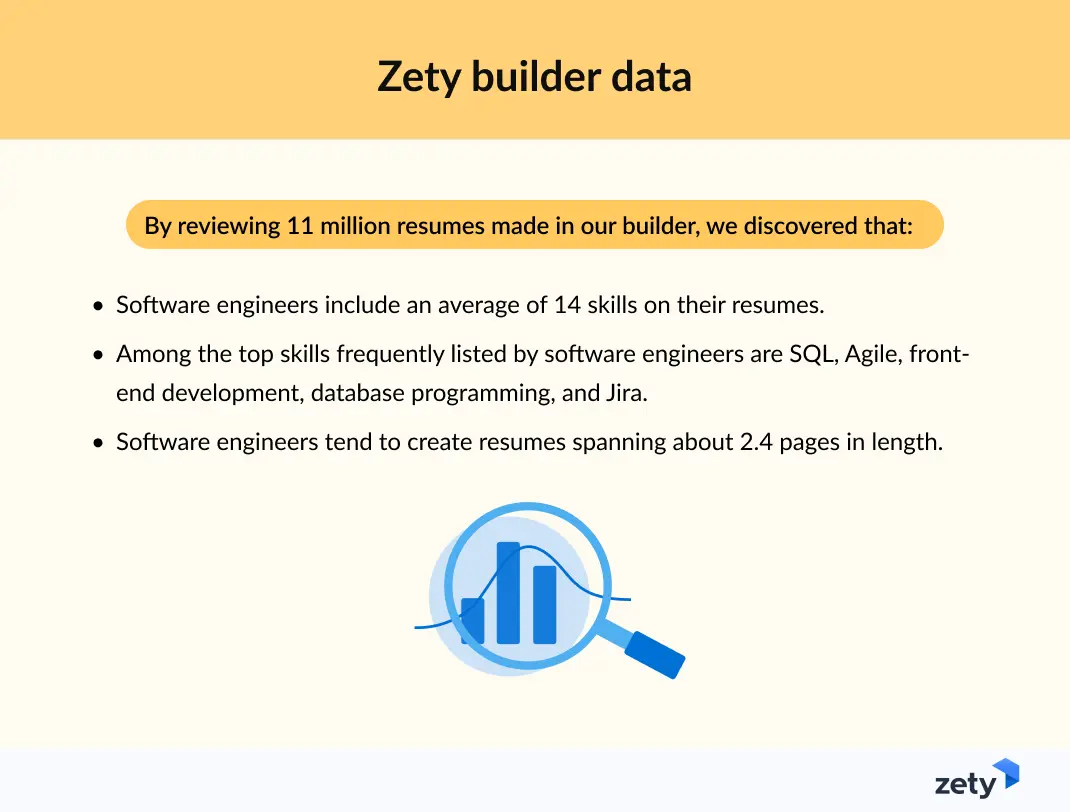
1. Use the Right Format for Your Software Engineer Resume Template
Before a recruiter even dives into your skills or GitHub link, they’ll judge your resume by its structure. Like clean code, a well-formatted software engineer resume makes everything easier to read, process, and appreciate. A sleek resume layout shows you value clarity, logic, and attention to detail—exactly what tech teams look for.
These are the most essential formatting tips for your software engineer resume:
- Choose a reverse-chronological format: It highlights your most recent engineering roles and relevant projects first—perfect for showing career growth and up-to-date skills.
- Use clean, modern fonts: Stick to developer-friendly fonts like Calibri, Arial, or Helvetica.
- Keep spacing readable: Between 1.0–1.15 for a clean, well-organized look that mirrors your best code formatting.
- Set font sizes smartly: Use 11–12 pt for regular text, and 13–14 pt for section headings to guide the reader without distraction.
- Keep margins uniform: 1-inch margins on all sides give your resume balance and prevent it from feeling cluttered.
- Export as a PDF: Unless the job posting says otherwise, save your resume as a PDF to preserve your formatting across platforms and screen sizes.
Pro Tip: Think of your resume format like your codebase—if it’s messy or hard to follow, no one will dig deeper. Keep it clean, readable, and logically structured to make a strong first impression.
2. Add Experience to Your Software Engineer’s Resume
The work experience section is the engine that drives your software engineer resume. It’s where you demonstrate how your technical know-how translates into real-world impact—whether that means shipping clean code, scaling infrastructure, or squashing bugs before launch.
With software engineering jobs projected to grow 17% between 2023 and 2033, standing out in a crowded, fast-growing field means more than listing duties. Tailor each entry to show measurable results, relevant tools, and the value you brought to each project or team.
Tailoring your work experience section shows hiring managers that you understand their needs and have the specific skills to solve their problems—it turns a good resume into a job-winning one.
How to structure your work experience:
- Use reverse-chronological order: Start with your most recent job.
- Include the essentials: Job title, company name, location, and employment dates.
- Use bullet points: Keep it scannable and prioritize clarity.
- Show impact with numbers: Quantify results when possible (e.g., "Improved load speed by 30%" or "Reduced bugs by 40%").
✅ Tips for strong software engineer resume bullet points:
- Begin with action verbs like "Developed," "Optimized," "Architected," "Launched."
- Mention the tech stack you used (e.g., React, Python, Kubernetes).
- Show your contribution to business or user outcomes.
Software Engineer
CodeSphere Technologies, San Diego, CA
April 2019–April 2025
Key Qualifications & Responsibilities
- Designed and implemented web applications using React, Node.js, and MongoDB.
- Developed RESTful APIs and microservices to support scalable backend systems.
- Collaborated with cross-functional teams using Agile methodologies and CI/CD workflows.
- Wrote unit and integration tests using Jest and Mocha to ensure code quality and reliability.
- Deployed applications to AWS and monitored performance using CloudWatch and Datadog.
Key Achievement
- Refactored a legacy backend module, reducing response time by 38% and improving application scalability.
Read more: Relevant Experience: What Does It Mean? [+ Examples]
3. Remember About the Education Section
Whether you’re a junior developer or a senior engineer, the education section of your software engineer resume helps establish your technical foundation. While it may carry more weight early in your career, it’s always worth presenting your education clearly and effectively.
How to format the education section:
- Degree Earned: Include your degree title (e.g., Bachelor of Science in Computer Science).
- School Name and Location: Add the full name of the institution and the city and state.
- Graduation Date: Include the month and year of graduation (or expected date).
- Relevant Coursework (Optional): This is helpful if you’re new to the field or your courses relate directly to the job.
- GPA (Optional): Only include it if it’s 3.5 or higher and you're early in your career.
Bachelor of Science in Computer Science
University of Texas, Austin, TX
September 2013–May 2017
Pro Tip: If you’ve earned certifications or completed bootcamps after graduation, you can list them in a separate Certifications section—or mention them here if they’re directly tied to your academic path.
4. Choose Relevant Software Engineer Skills for Your Resume
The skills section of your software engineer resume is your chance to show recruiters exactly what you bring to the table. Employers look for a combination of programming languages, frameworks, tools, and soft skills that prove you can build, maintain, and improve scalable systems.
Be sure to showcase both hard and soft skills on your resume. While computer skills, IT expertise, and programming languages are must-haves for any software developer, soft skills like collaboration and communication are just as important. In fact, they’re often undervalued in tech—highlighting them can set you apart and show you’re more than just technically capable.
Here’s how to list skills on your software engineer resume:
- Focus on relevance: Match your skills to the job description whenever possible.
- Use clear categories: If you want, you can break down your skills into technical, tools & platforms, and soft skills.
- Highlight proficiency: You can optionally group your skills by proficiency or experience level.
Take a look at the infographic below for some essential software engineer resume skills:
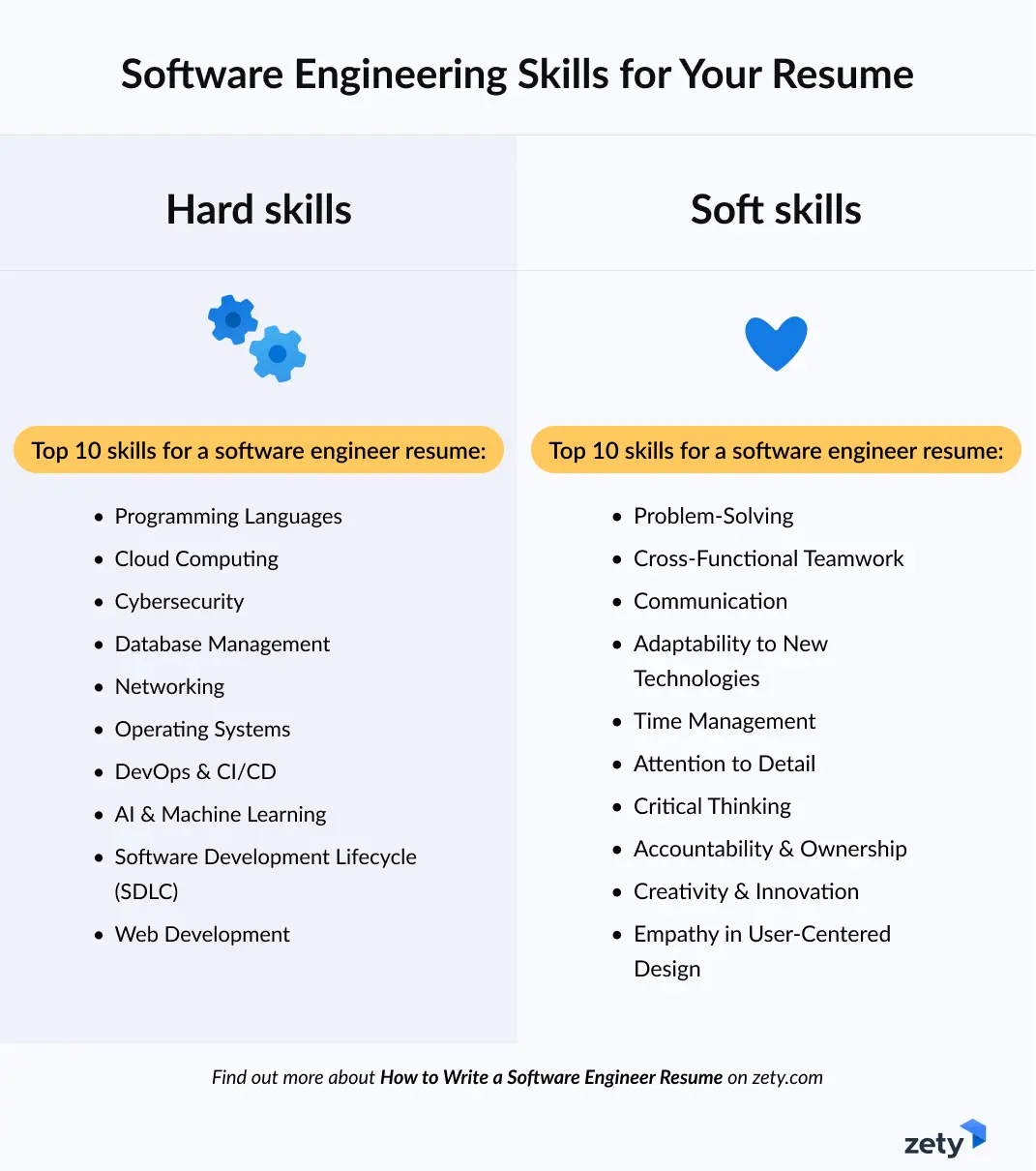
Pro Tip: Use the same wording as the job description when appropriate. It will help your resume for software engineer jobs get past ATS scans and into the hands of a recruiter.
5. Boost Your Software Engineer's Resume With Bonus Sections
Want your resume to rise above the rest? Including bonus resume sections can add serious value—whether you're fresh out of a coding bootcamp or a senior developer with years of experience. These extras show your initiative, passion for tech, and dedication to continuous learning.
Here are some high-impact extras for software engineer resumes:
- Certifications: Listing credentials like AWS Certified Developer or CompTIA Security+ proves you're up to speed with industry standards and technologies.
- Professional Development: Include online courses, bootcamps, or tech workshops—especially those focused on new frameworks, cloud computing, or DevOps practices.
- Awards & Recognitions: Whether it's a hackathon win or an internal "Developer of the Month" award, this section shows you’ve stood out from your peers.
- Volunteer Experience: Great for entry-level resumes or career changers—mention open-source contributions, nonprofit tech support, or coding mentorships.
Pro Tip: Don’t just list extra sections—connect them to the job. Tailor each one to support the core skills and tools mentioned in the job description. Think of it as adding context to your capabilities, not just content to your resume.
6. Include a Software Engineer Resume Summary or Objective
Your resume profile—whether a summary or objective—is your elevator pitch in code form. In just a few lines, it should spotlight your technical skills, career highlights, and what you bring to the table. A strong resume profile can immediately capture a hiring manager’s attention and set the tone for the rest of your resume.
Check out these tips for writing an effective software engineer resume profile:
- Start with a compelling adjective (e.g., innovative, detail-oriented).
- Include your job title (e.g., Backend Software Engineer).
- Mention how many years of experience you have.
- Call out a key accomplishment, like reducing load times or launching a scalable app.
- Wrap up with how you aim to contribute to the company’s development goals or tech stack.
Versatile and detail-oriented Software Engineer with 5+ years of experience in full-stack development, cloud integration, and scalable application design. Proficient in JavaScript, Python, and Java, with a strong background in Agile development and DevOps practices. At CodeSphere Technologies, refactored a core module that improved backend efficiency by 38%. Eager to build robust, user-centered applications at NextLayer Systems.
Pro Tip: Match your resume profile to your experience level. New to software engineering? Go with a resume objective. Got 2+ years under your belt? A resume summary will pack more punch.
7. Attach a Compelling Software Engineer Cover Letter
Even the best software engineer resume benefits from a tailored cover letter. It gives you a chance to speak directly to the employer, highlight your most relevant strengths, and explain why you're interested in the role—and the company.
How to write a great cover letter for software engineer jobs:
- Start with a personal greeting: If you know the hiring manager’s name, use it. Otherwise, "Dear Hiring Manager" works fine.
- Open strong: Mention the job title you’re applying for and what excites you about the role.
- Match your skills to the role: Reference the job description and explain how your background aligns with their tech stack, challenges, or goals.
- Give examples: Highlight key accomplishments, such as features you built, systems you optimized, or teams you led.
- Close with a call to action: Reiterate your interest and thank them for their time.
Example cover letter opening paragraph:
Dear Hiring Manager,
I’m writing to express my interest in the Software Engineer role at Skylark Systems. With 6+ years of experience developing scalable full-stack applications and a track record of improving performance by 30% at CloudNova Inc., I’m excited by the opportunity to bring my skills to your dynamic team.
Pro Tip: Don’t restate your resume—add context. A killer cover letter for software engineers connects your experience to the company’s mission and makes a compelling case for your fit.
Plus, a great cover letter that matches your resume will give you an advantage over other candidates. You can write it in our cover letter builder here. Here's what it may look like:
See more cover letter templates and start writing.
Expert Curated Video Content
If you prefer watching, our Certified Professional Resume Writer Caio will explain in detail how to write a software engineer resume in 5 minutes!
About Zety’s Editorial Process
This article has been reviewed by our editorial team to make sure it follows Zety's editorial guidelines. We’re committed to sharing our expertise and giving you trustworthy career advice tailored to your needs. High-quality content is what brings over 40 million readers to our site every year. But we don't stop there. Our team conducts original research to understand the job market better, and we pride ourselves on being quoted by top universities and prime media outlets from around the world.
